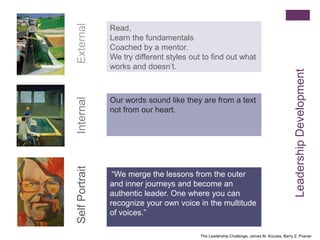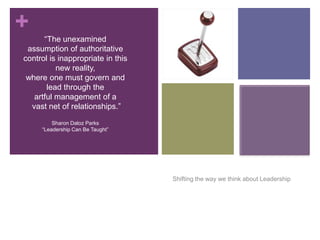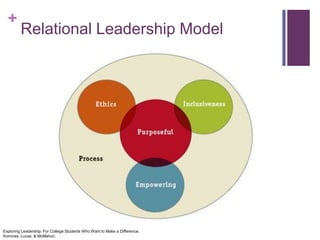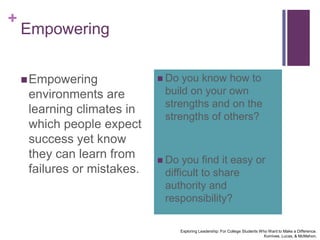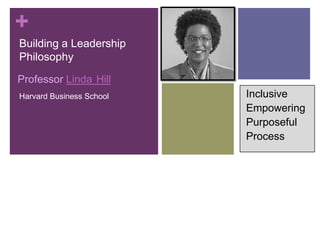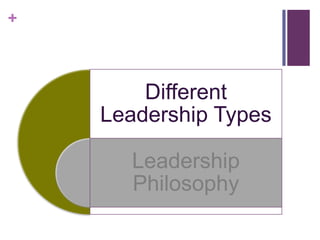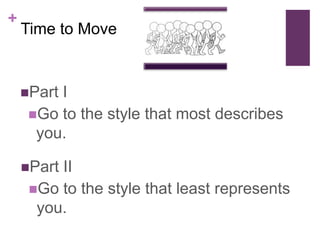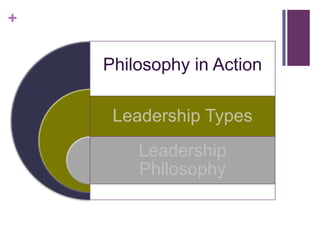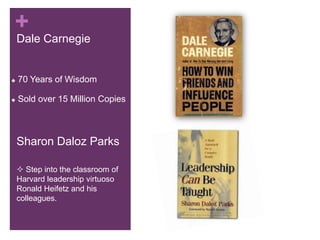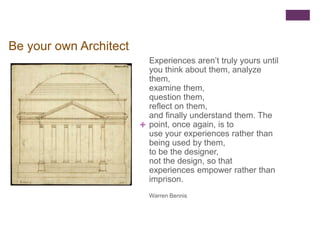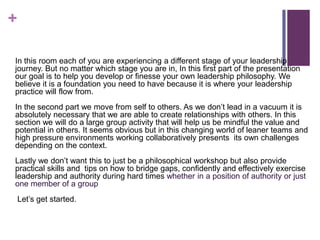MCPA Conference- Leadership in a World of Leaders
- 1. Cheryl Field & Michael KlitzkeMacalester CollegeLeadership in a world of leaders“Not who we “are” but what we “do”~Marshall Ganz
- 2. 123RecognizingDifferentLeadership Types~ Others ~A Model to help build a Leadership Philosophy~ Self ~Philosophy in Action~ Practice ~
- 3. the position or function of a leader: He managed to maintain his leadership of the party despite heavy opposition. Guidance; direction: The business prospered under the leadership of the new president.ability to lead: She displayed leadership potential. the position or function of a leader: He managed to maintain his leadership of the party despite heavy opposition. the leaders of a group: The union leadership agreed to arbitrate.an act or instance of leading; guidance; direction: They prospered under his leadership. How many definitions are there of Leadership? the leaders of a group: The union leadership agreed to arbitrate.ability to lead: She displayed leadership potential. Guidance; direction: The business prospered under the leadership of the new president.Capacity or ability to lead: showed strong leadership during her first term in office.the leaders of a group: The union leadership agreed to arbitrate.the position or function of a leader: He managed to maintain his leadership of the party despite heavy opposition. Guidance; direction: The business prospered under the leadership of the new president.
- 4. Shout outWho do you think of when you hearLEADER
- 6. Three Stages of Self ExpressionExterior LandscapeInterior LandscapeSelf PortraitPainted by: Richard Diebenkorn
- 7. Read, Learn the fundamentals Coached by a mentor.We try different styles out to find out what works and doesn’t.ExternalOur words sound like they are from a text not from our heart. InternalLeadership Development“We merge the lessons from the outer and inner journeys and become an authentic leader. One where you can recognize your own voice in the multitude of voices.”Self PortraitThe Leadership Challenge, James M. Kouzes, Barry Z. Posner
- 9. “The unexamined assumption of authoritative control is inappropriate in this new reality, where one must govern and lead through the artful management of a vast net of relationships.”Sharon Daloz Parks“Leadership Can Be Taught”Shifting the way we think about Leadership
- 10. Relational Leadership ModelExploring Leadership: For College Students Who Want to Make a Difference. Komives, Lucas, & McMahon.
- 11. InclusiveListening with empathy and communicating with civility are communication skills that facilitate the inclusion of others. How comfortable and effective are you with including others?Do you understand your own motivations when you agree or disagree with others?Exploring Leadership: For College Students Who Want to Make a Difference. Komives, Lucas, & McMahon.
- 12. EmpoweringEmpowering environments are learning climates in which people expect success yet know they can learn from failures or mistakes. Do you know how to build on your own strengths and on the strengths of others?Do you find it easy or difficult to share authority and responsibility?Exploring Leadership: For College Students Who Want to Make a Difference. Komives, Lucas, & McMahon.
- 13. PurposefulBuilding a vision from among group members, recognizing that people support what they help create. Do you have to get your own way, or are you able to find common purpose with others?Do you have a clear goal and an awareness of commitments that are important to you?Exploring Leadership: For College Students Who Want to Make a Difference. Komives, Lucas, & McMahon.
- 14. Process OrientatedProcess refers to how the group goes about being a group, remaining a group, and accomplishing a group’s purposes. How effective are you at civil discussions, even when you strongly disagree with someone?Do you know what approaches you prefer for facilitating change?Exploring Leadership: For College Students Who Want to Make a Difference. Komives, Lucas, & McMahon.
- 15. Ethical“Leaders must consider the impact they have on their followers as well as on others external to the group, organization or society.”Can you identify the values and principles that guide your actions?Do you find it easy to act with integrity and authenticity?Leadership a Communication Perspective. Michael Z. Hackman & Craig E. JohnsonExploring Leadership: For College Students Who Want to Make a Difference. Komives, Lucas, & McMahon.
- 16. Building a Leadership PhilosophyProfessor LindaHillInclusive Empowering Purposeful ProcessHarvard Business School
- 18. “Leadership is always dependent on the context, but the context is established by the relationships we value.”Wheatley, 1992Shifting the way we think about Leadership
- 19. Leadership Styles Learning Leaderby Douglas B. ReevesVisionaryarticulating a compelling vision and linking clear standards of action that will accomplish the vision. visions are more likely to be the blueprints of the architect than the uncertain and cloudy visions of the dreamerAnalytical master of budget details, assessment scores, and statistical data; analytical leaders are not masters of answers but rather persistent questionersSystematicAbility to see complex connections, and understanding these complex interactions. They recognize the various parts of the organization, and, in particular, the interrelations of the parts Collaborative“Exchanging information, pooling resources for mutual benefit to achieve a common purpose”We need more than well-developed individuals. We need well developed connections between individuals and deeper and more meaningful relationships around shared work
- 20. Time to MovePart IGo to the style that most describes you.Part IIGo to the style that least represents you.
- 21. Imagine you were all working on a team together. How would the team work if it had only 2 or 3 out of the 4 styles?1.“Our culture tells us we are autonomous. Actually, we are each an integral part of multiple systems.” Harvard Business School Press “Leadership Can Be Taught”2.Thoughts3.How does this statement challenge traditional definitions of what it means to be a leader?
- 22. Work from a strongfoundational leadership philosophy that informs your leadership practice. Even if your not in a position of power, role model your philosophy.Leadership StylesRecognize where your strengthsend and others strengths beginas an opportunity to empowerothersPhilosophy in Action
- 24. Dale Carnegie 70 Years of Wisdom
- 25. Sold over 15 Million CopiesSharon Daloz Parks Step into the classroom of Harvard leadership virtuoso Ronald Heifetz and his colleagues. Navigating PracticeLeadership vs. Managing vs. AuthoritySelf and RoleBlind Spots Become New Vistas Turn to the person next to you and discuss how these play out for you.
- 26. Listening to the Music Behind the wordsList 2 or 3 things you will take away from this session.
- 27. Be your own ArchitectExperiences aren’t truly yours until you think about them, analyze them, examine them, question them, reflect on them, and finally understand them. The point, once again, is to use your experiences rather than being used by them, to be the designer, not the design, so that experiences empower rather than imprison.Warren Bennis
- 28. ReferencesThe Leadership Challenge, James M. Kouzes, Barry Z. PosnerExploring Leadership: For College Students Who Want to Make a Difference. Komives, Lucas, & McMahonLeadership a Communication PerspectiveMichael Z. Hackman & Craig E. JohnsonLearning Leader, article by Douglas B. ReevesHow to Win Friends and Influence People, Dale CarnegieLeadership Can Be Taught, A Bold Approach for a Complex World, Sharon Daloz ParksWhere Will We Find Next Generations Leaders? Video Prof. Linda HillPaintings by: Richard Diebenkorn
- 29. Cheryl Field & Michael KlitzkeMacalester CollegeLeadership in a world of leaders“Not who we “are” but what we “do”~Marshall Ganz
- 30. Be a Leader: How to Change People Without Giving Offense or Arousing ResentmentBegin with praise and honest appreciation. Call attention to other people's mistakes indirectly. Talk about your own mistakes first. Ask questions instead of directly giving orders. Let the other person save face. Praise every improvement.Give them a fine reputation to live up to.Encourage them by making their faults seem easy to correct. Make the other person happy about doing what you suggest.
- 31. Shout outWho do you think of when you hearLEADER
- 33. Senator Robert KennedyCape Town, in South Africa in 1966
- 34. “They are real women who have cried, sweat and bled, each making her own life the raw material from which a role model has arisen.” Marian Pearle Julian Atim MDSomaly MamSiila Watt- Cloutier
- 35. Chinese Symbol for ListeningThe Four Rules of Active Listening 1. Seek to understand before you seek to be understood. 2. Be non judgmental 3. Give your undivided attention to the speaker 4. Use silence effectively YouEarEyesUndivided AttentionHeart
- 37. In this room each of you are experiencing a different stage of your leadership journey. But no matter which stage you are in, In this first part of the presentation our goal is to help you develop or finesse your own leadership philosophy. We believe it is a foundation you need to have because it is where your leadership practice will flow from. In the second part we move from self to others. As we don’t lead in a vacuum it is absolutely necessary that we are able to create relationships with others. In this section we will do a large group activity that will help us be mindful the value and potential in others. It seems obvious but in this changing world of leaner teams and high pressure environments working collaboratively presents its own challenges depending on the context.Lastly we don’t want this to just be a philosophical workshop but also provide practical skills and tips on how to bridge gaps, confidently and effectively exercise leadership and authority during hard times whether in a position of authority or just one member of a group Let’s get started.
Editor's Notes
- NameWe are excited to present our topic, Leadership in a world of leaders…Catchy title huh? Very academic sounding and lofty…Let me tell you about the flow of the session we don’t want to stand infront of you and droan on for 50 minutes. We’ve designed this session in three parts. In the first part, I will droan on for a bit as we set the stage for our conversation and then discuss a model to help us create a leadership PhilosophyThen we will watch a video and in the second part we will do a large group activity around defferent leadership types and the last section is reflecting about the challeges on how to put theory in to practice.So lets dive right in huge beast called leadership.
- These people and those that you mentioned are definitely leaders. Personally it is hard to identify myself as a leader or think of myself as a real leader when this is the image I have in my head. Before us are fully formed leaders but to bring leadership down from its pedestal I’d like us to think about the individual journey, the leadership journey each person went on. Some of those journeys may have been easier than others. Some people found themselves, powerless, marginalized with little or no resources or formal training. It is this journey, your journey that I want us to think about. To help me do that I want to talk about a chapter from the Leadership Challange called the three stages of self expression
- Many of you may have read The leadership Challenge. If you haven’t I encourage you to. There is a section called The three stages of self expression. In it they tell a story about an outing in a gallery they had with an artist friend. At the end of a retrospective work Richard Diebenkorn their artist friend said.There are really three periods in an artist’s life. In the first period, we paint exterior landscapes. In the second, we paint interior landscapes. In the third, we paint our selves.”The authors liken that to leadership development
- In this room each of you are experiencing a different stage of your leadership journey. But no matter which stage you are in, In this first part of the presentation our goal is to help you develop or finesse your own leadership philosophy. We believe it is a foundation you need to have because it is where your leadership practice will flow from. And to help us do that, I want to briefly introduce the Relational Leadership Model
- How many of you are familiar with this model? It is an aspirationalModel or framework that can help us build our own leadership philosophy and help us work through a leadership process as a group. This is a simple representation of the model but the concepts are quite complex. I’m going to run through the essences of each of component and I would like you to consider how comfortable you are with each component think about them in the context of your own work environment or role. How do each of these play out? Is there a one component you do better than others. How can I improve my practice or that of the group.
- I realize I have been droaning on and now I would like us to watch a short clip about five minutes of Prof Linda Hill talk about these concepts, not by referencing therealtional leadership model but listen for the words like inclucive empowering purposeful process, creating context.
- In the second part we move from self to others. As we don’t lead in a vacuum it is absolutely necessary that we are able to create relationships with others. In this section we will do a large group activity that will help us be mindful the value and potential in others. It seems obvious but in this changing world of leaner teams and high pressure environments working collaboratively presents its own challenges depending on the context.
- Lastly we don’t want this to just be a philosophical workshop but also provide practical skills and tips on how to bridge gaps, confidently and effectively exercise leadership and authority during hard times whether in a position of authority or just one member of a group
- These people and those that you mentioned are definitely leaders. Personally it is hard to identify myself as a leader or think of myself as a real leader when this is the image I have in my head. Before us are fully formed leaders but to bring leadership down from its pedestal I’d like us to think about the individual journey, the leadership journey each person went on. Some of those journeys may have been easier than others. Some people found themselves, powerless, marginalized with little or no resources or formal training. It is this journey, your journey that I want us to think about. To help me do that I want to talk about a chapter from the Leadership Challange called the three stages of self expression






